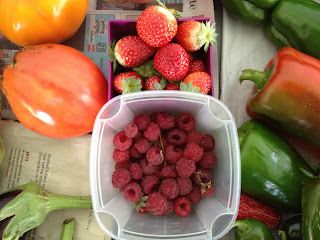One Last Summer Harvest
We often don’t have a killing frost here the first couple times it’s predicted, protected as we are by the ocean, which acts as a big heat source and keeps our temperatures slightly warmer in the winter and cooler in the summer. In the game of protecting tender plants, those few degrees in either direction are crucial.
This year, though, there was no flirting with 33 degree nights. The temperature dropped right down to 30 last night, and that did in the last of the summer fruits. We prepared to protect our leafy greens, and yesterday I also went through the garden to pick anything that looked big enough to be worth saving:
As a general rule of thumb, fruits will not survive a frost, but root vegetables will be just fine until a hard freeze, thanks to the insulating power of the earth. Leafy vegetables are a toss up: Basil gave up long ago and green beans are out, but arugula, cabbage, and kale are fine. Broccoli is also usually pretty tough, but we were planning on a stir fry for dinner, so I picked them anyway. To that end, I also grabbed some Swiss chard that would have been inconvenient to cover:
And, yes, we still have some watermelon to work through. Next year we will try a smaller, seedless variety, as these are always too big for us to finish and a pain to eat for lunch in public, as they require a fair amount of seed-spitting.
As you can see in the first photo, I brought in a lot of fruits: eggplant, tomatoes, bell peppers, and jalapeños. I also brought in the last strawberries and raspberries:
Not pictured is a basket full of small butternut squash (maybe a dozen of them). I also brought in lots of green tomatoes:
These are good for pickling, frying, or (my favorite) pie making. You can also store them in newspaper and allow them to ripen slowly on their own. They won’t be great, but still better than a sad grocery store one.







Comments
Post a Comment